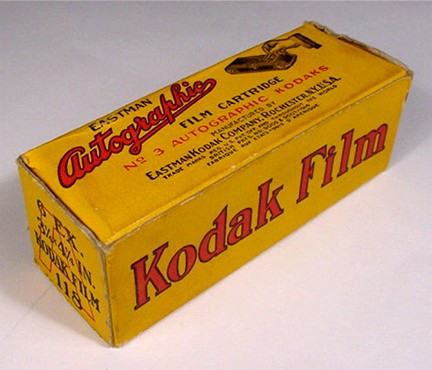
Eastman Autographic Film Cartridge, Size A118

Eastman Autographic Film Cartridge, Size A118
This is an unopened box of sixe A118 Eastman Autographic film with an expiration date of October, 1929. This film cartridge was made for use in No. 3 Autographic Kodak cameras. No. 3 Kodak cameras produced six 3 1/4 x 4 1/4 inch or 8 x 10.5 cm exposures.
Autographic film, introduced in 1914, allowed photographers to make notes about their photograph and have those notes appear in the margin of the processed print.
The back of an Autographic Kodak camera has a narrow slot that is covered by a light-tight door. To make a note the door was lifted, giving access to the film's paper backing. Autographic cameras were provided with a writing instrument called a stylus. The stylus was used to scribe the notation onto the paper backing. To capture the handwriting, the door was left open for a few seconds, exposing the marked area to the light. The Vanity Kodak page shows an Autographic camera and stylus.
A large red letter A and the number 118 are printed on the end of the film box. The A indicates that this is Autographic film. The Kodak size designation is 118. Size 118 film was available in both Autographic and standard (non-Autographic) versions. Either type of film could be used in Autographic or standard cameras, but of course the Autographic feature required an Autographic camera loaded with Autographic film.
Eastman Kodak manufactured Autographic film in eight different sizes. Each size was also available as non-Autographic film.
| Film Size | Camera Size | Image Size in Inches |
|---|---|---|
| A116 | 1A, 2A | 2 1/2 x 4 1/4 |
| A118 | 3 | 3 1/4 x 4 1/4 |
| A120 | 1, 2 | 2 1/4 x 3 1/4 |
| A122 | 3A | 3 1/4 x 5 1/2 (Postcard) |
| A123 | 4 | 4 x 5 |
| A126 | 4A | 4 1/4 x 6 1/2 |
| A127 | Vest Pocket (VP) | 1 5/8 x 2 1/4 |
| A130 | 2C | 2 7/8 x 4 7/8 |
Table notes: Camera size refers to Kodak's model numbering system where all cameras of a given model number used the same film size number. For example, a No. 1A Autographic Kodak used the same film size as a No. 1A Autographic Kodak Junior. During and after the Autographic camera years, this system was consistent. However, camera model numbers assigned before this period did not necessarily follow this pattern. One example of this inconsistency would be the No. 2 Folding Pocket Kodak which took 3 1/2 x 3 1/2 inch exposures on size 101 roll film. Notice in the table above that a No. 2 Camera Size corresponds with size 120 roll film and image dimensions of 2 1/4 x 3 1/4 inches.
The Autographic process was invented by Henry J. Gaisman, a prolific inventor and founder of the AutoStrop Company, a safety razor manufacturer. George Eastman purchased the rights to Henry Gaisman's invention in 1914 for 300,000 US dollars.
Over a period of twenty years Kodak created dozens of Autographic camera models. Autographics were very popular and sold in great numbers. Manufacture of Autographic cameras ceased in 1934. Most models of Autographic cameras are easily found by collectors today. But a few camera models, and items such as this film box are more difficult to locate.
I've managed to find examples of all 8 Autographic film boxes for my collection, along with a few duplicates. I found the final unique box of film 10 years after I acquired my first.
Over the years, at flea markets and antique stores I've searched through boxes of old snapshots, but I rarely find Autographic prints with notations in the margins. If my experience is typical, then it makes me wonder if the Autographic feature was used very often?

|
Page created July 25, 2001; updated December 20, 2020
|